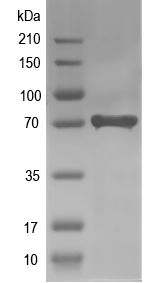Protein expression services for KCND2 | Potassium voltage-gated channel subfamily D member 2
Description
Voltage-gated potassium channel that mediates transmembrane potassium transport in excitable membranes, primarily in the brain, but also in rodent heart. Mediates the major part of the dendritic A-type current I(SA) in brain neurons (By similarity). This current is activated at membrane potentials that are below the threshold for action potentials. It regulates neuronal excitability, prolongs the latency before the first spike in a series of action potentials, regulates the frequency of repetitive action potential firing, shortens the duration of action potentials and regulates the back-propagation of action potentials from the neuronal cell body to the dendrites. Contributes to the regulation of the circadian rhythm of action potential firing in suprachiasmatic nucleus neurons, which regulates the circadian rhythm of locomotor activity (By similarity). Functions downstream of the metabotropic glutamate receptor GRM5 and plays a role in neuronal excitability and in nociception mediated by activation of GRM5 (By similarity). Mediates the transient outward current I(to) in rodent heart left ventricle apex cells, but not in human heart, where this current is mediated by another family member. Forms tetrameric potassium-selective channels through which potassium ions pass in accordance with their electrochemical gradient. The channel alternates between opened and closed conformations in response to the voltage difference across the membrane. Can form functional homotetrameric channels and heterotetrameric channels that contain variable proportions of KCND2 and KCND3; channel properties depend on the type of pore-forming alpha subunits that are part of the channel. In vivo, membranes probably contain a mixture of heteromeric potassium channel complexes. Interaction with specific isoforms of the regulatory subunits KCNIP1, KCNIP2, KCNIP3 or KCNIP4 strongly increases expression at the cell surface and thereby increases channel activity; it modulates the kinetics of channel activation and inactivation, shifts the threshold for channel activation to more negative voltage values, shifts the threshold for inactivation to less negative voltages and accelerates recovery after inactivation. Likewise, interaction with DPP6 or DPP10 promotes expression at the cell membrane and regulates both channel characteristics and activity (By similarity).
Family
Belongs to the potassium channel family. D (Shal) (TC 1.A.1.2) subfamily. Kv4.2/KCND2 sub-subfamily.
Species
Mustela putorius furo
Length
630 amino acids
Sequence
MAAGVAAWLPFARAAAIGWMPVASGPMPAPPRQERKRTQDALIVLNVSGTRFQTWQDTLERYPDTLLGSSERDFFYHPETQQYFFDRDPDIFRHILNFYRTGKLHYPRHECISAYDEELAFFGLIPEIIGDCCYEEYKDRRRENAERLQDDADTDNTGESALPTMTARQRVWRAFENPHTSTMALVFYYVTGFFIAVSVIANVVETVPCGSSPGHIKELPCGERYAVAFFCLDTACVMIFTVEYLLRLAAAPSRYRFVRSVMSIIDVVAILPYYIGLVMTDNEDVSGAFVTLRVFRVFRIFKFSRHSQGLRILGYTLKSCASELGFLLFSLTMAIIIFATVMFYAEKGSSASKFTSIPAAFWYTIVTMTTLGYGDMVPKTIAGKIFGSICSLSGVLVIALPVPVIVSNFSRIYHQNQRADKRRAQKKARLARIRAAKTGSANAYMQSKRNGLLSNQLQSSEDEQAFVSKSGSSFETQHHHLLHCLEKTTNHEFVDEQVFEESCMEVATGNRPSSHSPSLSSQQGVTSTCCSRRHKKTFRIPNANVSGSHRGSVQELSTIQIRCVERTPLSNSRSSLNAKMEECVKLNCEQPYVTTAIISIPTPPVTTPEGDDRPESPEYSGGNIVRVSAL
Mass
70.6 kDa
Simulated SDS-PAGE
 (Note: Representative image - actual molecular weight may vary depending on tag type and expression method)
(Note: Representative image - actual molecular weight may vary depending on tag type and expression method)Safety
Upon ordering, we will perform rigorous biosecurity and export control screening to ensure that order fulfillment is consistent with all legal and regulatory guidance.
Protein synthesis service
Make KCND2 using our protein expression services starting at $99 + $.30/amino acid in as fast as two weeks (includes the cost of DNA synthesis)
Order Here